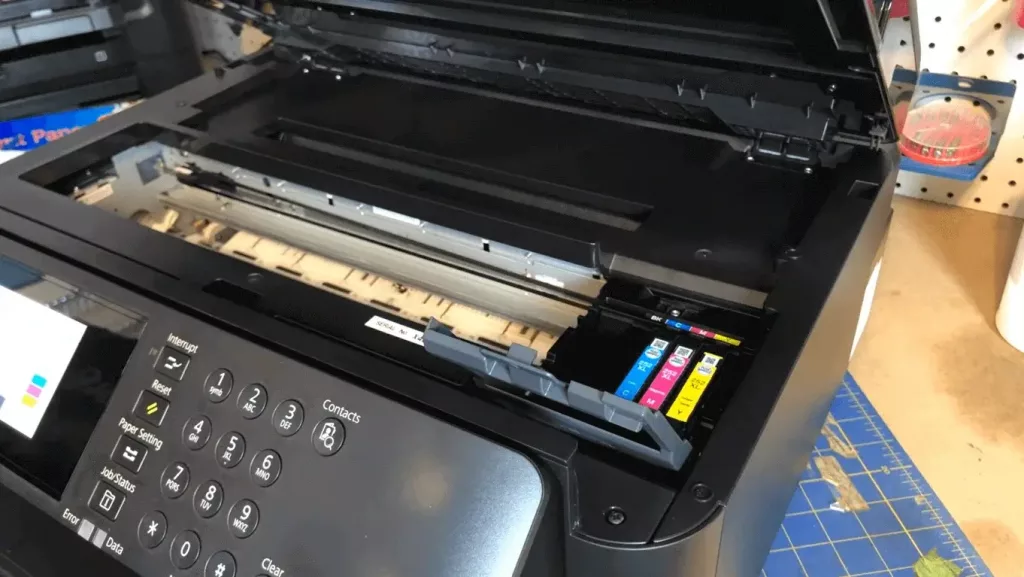Switching Pro to Advanced is always rewarding. Your skills and ROI will rise simultaneously. Tell us who does want this.
Sure thing! You are here for that too! Maybe you are planning to step up the era of dye-sublimation technology.
But confused about either inkjet or the sublimation printer. No worries! We are here to solve that puzzle.
Dye Sublimation printers provide superior image quality and long-lasting prints, ideal for professional photography and specialized applications. Inkjet printers, on the other hand, offer versatility and cost-effectiveness, making them suitable for everyday printing tasks with good quality results.
This Dye sublimation vs Inkjet printer comparison will light you up in-depth. Not only that but also it will reveal some secret facts.
50 American experts share all of these. Check the article slowly. You will find the gem inside each section. Let’s dig it out.
What is Dye Sublimation?
The definition is a bit critical. We will ease that up here. Dye-sublimation is a process to turn a solid color into gas.

Brief: Regular printers like inkjets spray the color over the paper; then, it heats through a drier. The drier later makes the color permanent and creates a better graphical illustration. Right?
Dye Sublimation, on the other hand, follows the same method. Just one extensive method makes it unique. The method is as follows:
The printer sprays the solid color over a specialized transfer paper. The sprayed colors look a bit scattered.
Then it heats up to vaporize the solid color to put in an object. Objects like business cards, clothes, banners, coffee mugs, and more. The basic concept of this printing is to define the graphical illustration better.
Fact: sublimation process is 63 years old. We are saying it is updated, but no! The technology has been updated, but not the process.
What is an Inkjet Printer?
Inkjet printers use two technologies: bubble jet and piezoelectric. A bubble jet vaporized the ink and turned it into bubbles.
Later it sends the bubble through nozzles. The piezoelectric process is a bit different. It heats the ink through vibration and sends it through the nozzle.
When the nozzle drops the ink, the drier start to heat up, it matures the idea and finalizes through a better outcome.
Fact: the price of a gallon of ink for an inkjet printer is $4000.
Advantages of Dye Sublimation
You know the basics of inkjet and dye sublimation. Now we will cover the advantages of each printer. Starting with Dye-Sublimation.
1. Stunning Image Quality: Dye sublimation produces vivid images with precise color reproduction, accurate dots, and smooth color transitions, ensuring exceptional print results that don’t compromise on quality.
2. Unmatched Durability: Unlike regular printers that may fade or blur over time, dye-sublimation prints remain highly durable. The colors stay vibrant and the details sharp, maintaining a youthful glow that lasts.
3. Hassle-Free Handling: With dye sublimation, there’s no need to handle prints delicately or worry about scattered colors. You can fold, carry, or manipulate the prints without any loss of image quality or color consistency.
4. True-to-Life Color Reproduction: Dye sublimation retains the authenticity of colors, eliminating any glare or artificial effects. Every minute detail is faithfully captured, resulting in prints that showcase the exact color variations and subtleties of the original artwork or photograph.
5. Versatile Applications: Dye sublimation offers endless possibilities. Whether you’re printing on fabric, mugs, or various hard materials, the graphical outcomes are awe-inspiring. The color and image quality remain uncompromised, making it an ideal choice for a wide range of creative projects.
Fact: The actual term for Dye-Sublimation is: “Dye-Diffusion.”
Disadvantages of Dye Sublimation
Likewise the advantages, it has some disadvantages. People shared a lot of drawbacks of these printers.
We don’t agree with all of them. Here are some major drawbacks. These are not a dealbreaker for sure.
1. Limited Paper Compatibility: Dye sublimation printers require white or light-coated paper, making it unsuitable for printing on dark-colored paper. This limitation restricts the range of paper options available for certain projects.
2. Printhead Maintenance: Continuous use is necessary to prevent printhead clogging in dye sublimation printers. This may result in slightly higher electricity consumption, as the printer needs to remain powered on even during periods of inactivity.
3. Color Fading in Sunlight: Dye sublimation prints may experience a reduction in color quality when exposed to direct sunlight, especially in areas with poor UV protection. To ensure long-lasting colors, it’s advisable to avoid displaying prints in direct sunlight or areas with high UV exposure.
Fact: Noel de Passe is the inventor of Dye sublimation
Advantages of Inkjet Printer

Now let’s dive into the advantages of inkjet printers. The following benefits are common in 90% of users.
1. Cost-Effective Image Quality: Inkjet printers provide good image quality at an affordable price point. While it may not match the output of dye sublimation, you can still achieve satisfactory results within a budget, ensuring you get your money’s worth.
2. Compact and Space-Saving: Inkjet printers are designed to be compact, making them easy to fit alongside your laptop or in small workspaces. Their smaller footprint allows for convenient placement and efficient space utilization.
3. Affordable Initial Investment: Compared to dye-sublimation printers, inkjet printers have a lower initial cost. This affordability makes them accessible to a wider range of users, allowing for cost-effective printing solutions without compromising on basic printing needs.
Fact: Brother recycles thousands of toners to save trees. This initiative is for enhancing the environmental diversity of koalas.
Disadvantages of Inkjet Printer
Some of these disadvantages we faced while we were analyzing the advantages. Check this out.
1. Slower Printing Speed: Inkjet printers tend to have slower printing speeds compared to other types of printers. It can take a longer time to print a larger number of pages, making them less suitable for high-volume printing requirements.
2. Costly Cartridges: One of the significant drawbacks of inkjet printers is the high cost of ink cartridges. Replacing ink cartridges can be expensive, especially for printers with multiple color cartridges, which can add up to the overall printing costs.
3. Ink Drying Issues: Inkjet printers are prone to ink drying out if they are not used regularly. This can lead to clogged print heads and poor print quality. To prevent this, it’s necessary to keep the printer powered on or perform regular maintenance routines to keep the ink flowing smoothly.
Fact: Every Inkjet printer has thousands of computer chips to check the ink level. You can reset it to enhance efficiency.
Dye Sublimation vs. Inkjet Printers – Head to Head
Time to share some more interesting information. You can call this a final touch. We will do a head-to-head comparison. It will help you to make a better buying decision.
Printing Process
Inkjet and dye-sublimation printers have different printing processes. Explaining the Dye-sublimation process first:
Over a transfer paper, a graphic is printed for the first time. Then the paper is placed over the decorated object (banner, coffee mug, business card). By using the heat press, the solid ink vaporized finally to bond with the material.
Simple! Right? The Inkjet printing process is also the same. As soon as it gets the command, a thousand nozzles are electrified to vaporize the inks. The ink then sprays the droplets over the paper. The paper later heats up to stable the ink construction. Done!
Color Quality
Dye-sublimation printers serve the best eye experience. The color grades are smooth and aligned.
Compared with this printer, Inkjet cannot deliver that satisfying look. It seems more generic than specific.
You can use the photo for a demo. We don’t prefer this for the final project unless you have dye sublimation.
Efficiency
We prefer dye-sublimation printers for ultimate efficiency. The color grades are super-specific, and there is no chance of decay.
But Inkjet may decay over time. Over everything, it’s all about cost-efficiency. Inkjet and dye sublimation offers the same cost. Since both are offering the same cost, why should you compromise on the quality?
Easy to use
Inkjet is easy to use. We think it has a competitive advantage here. It has fewer technical difficulties than dye-sublimation.
A dye-sublimation printer takes time to set up for initial printing. If you are not expert enough, there is a chance of ruining…
Dye Sublimation vs Inkjet Printer – Comparison Table
| Points | Dye Sublimation Printer | Inkjet Printer |
|---|---|---|
| Image Quality | High-quality, vibrant prints with precise colors and smooth gradients. | Good image quality, but may not match the detail and color accuracy of dye sublimation. |
| Durability | Highly durable prints that resist fading, even in harsh conditions. | Average durability may fade over time, especially when exposed to sunlight. |
| Paper Compatibility | Limited to white or light-coated paper, not suitable for dark-colored paper. | Versatile, capable of printing on various paper types, including dark-colored paper. |
| Printing Speed | Moderate to fast printing speed for small to medium-sized print jobs. | Slower printing speed compared to dye sublimation. |
| Cost of Consumables | Higher cost per print due to specialized dye sublimation inks and transfer papers. | Lower cost per print with standard ink cartridges, but ink replacements can add up over time. |
| Versatility | Limited to specialized applications like fabric or hard material printing. | Versatile, suitable for a wide range of printing needs, including documents, photos, and more. |
| Maintenance | Requires minimal maintenance, with occasional printhead cleaning. | May require more frequent maintenance, including printhead cleaning and cartridge replacements. |
Printing Samples – Dye Sublimation & Inkjet Printing
Dye Sublimation



Inkjet Printing



FAQs
Can You Use an Inkjet Printer for Sublimation?
It’s a complicated question. If you want a straight answer, it will be a big “NO.” all inkjet printers are not capable of sublimation. Only the piezoelectric dedicated printers are capable of sublimation.
Can I sublimate on cotton?
Yes, you can. Put a polyester coating over the cotton layer. Now you are all set to sublimate. Remember one thing: sublimation works great with polyester.
What is the difference between an inkjet printer and a regular printer?
The major difference between polyester and a regular printer is “Process” Inkjet vaporizes the ink and sprays it through the nozzles. But regular printers like laser printers use laser and photosensitive drums to perform the process.
Is dye sublimation better than an inkjet?
It depends on your specific needs and requirements. Dye sublimation offers superior image quality and durability, making it ideal for specialized applications like photography or high-end graphics. Inkjet printers are more versatile, cost-effective, and suitable for everyday printing tasks. Consider your priorities and choose the option that aligns best with your printing needs.
What secret facts do 50% of Americans share with us?
In our article, we covered a lot of information, including the facts. That’s the thing 50% of Americans share. We fetched that from direct email, threads, and live sessions.
We still believe the topic has not been covered yet fully. Our team will update it based on your comments.
Let us know more about Dye sublimation vs. Inkjet. We would love to analyze the ideas to attach to our content.
One more thing: did you count how many facts we shared today? If so, tell us: Why is Brother recycling the toner? The winner will get a free brochure of the best deals. Want to win? Shout out loud.